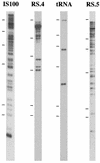The 102-kilobase unstable region of Yersinia pestis comprises a high-pathogenicity island linked to a pigmentation segment which undergoes internal rearrangement
- PMID: 9573181
- PMCID: PMC107171
- DOI: 10.1128/JB.180.9.2321-2329.1998
The 102-kilobase unstable region of Yersinia pestis comprises a high-pathogenicity island linked to a pigmentation segment which undergoes internal rearrangement
Abstract
Several pathogenicity islands have recently been identified in different bacterial species, including a high-pathogenicity island (HPI) in Yersinia enterocolitica 1B. In Y. pestis, a 102-kb chromosomal fragment (pgm locus) that carries genes involved in iron acquisition and colony pigmentation can be deleted en bloc. In this study, characterization and mapping of the 102-kb region of Y. pestis 6/69 were performed to determine if this unstable region is a pathogenicity island. We found that the 102-kb region of Y. pestis is composed of two clearly distinct regions: an approximately 35-kb iron acquisition segment, which is an HPI per se, linked to an approximately 68-kb pigmentation segment. This linkage was preserved in all of the Y. pestis strains studied. However, several nonpigmented Y. pestis strains harboring an irp2 gene have been previously identified, suggesting that the pigmentation segment is independently mobile. Comparison of the physical map of the 102-kb region of these strains with that of strain 6/69 and complementation experiments were carried out to determine the genetic basis of this phenomenon. We demonstrate that several different mechanisms involving mutations and various-size deletions are responsible for the nonpigmented phenotype in the nine strains studied. However, no deletion corresponded exactly to the pigmentation segment. The 102-kb region of Y. pestis is an evolutionarily stable linkage of an HPI with a pigmentation segment in a region of the chromosome prone to rearrangement in vitro.
Figures




References
-
- Buchrieser C, Buchrieser O, Kristl A, Kaspar C W. Clamped homogeneous electric fields (CHEF) gel-electrophoresis of DNA restriction fragments for comparing genomic variations among strains of Yersinia enterocolitica and Yersinia spp. Zentralbl Bakteriol. 1994;281:457–470. - PubMed
Publication types
MeSH terms
Substances
LinkOut - more resources
Full Text Sources
Research Materials

